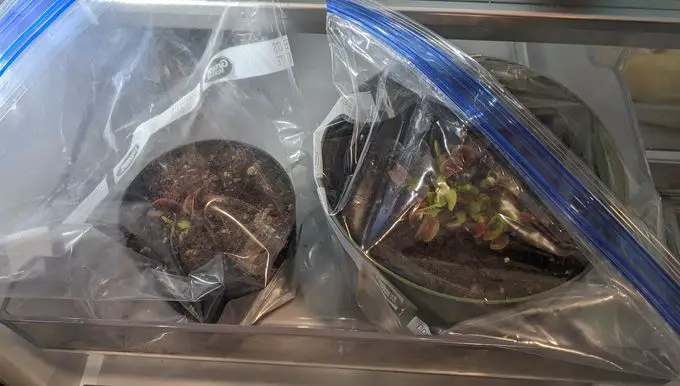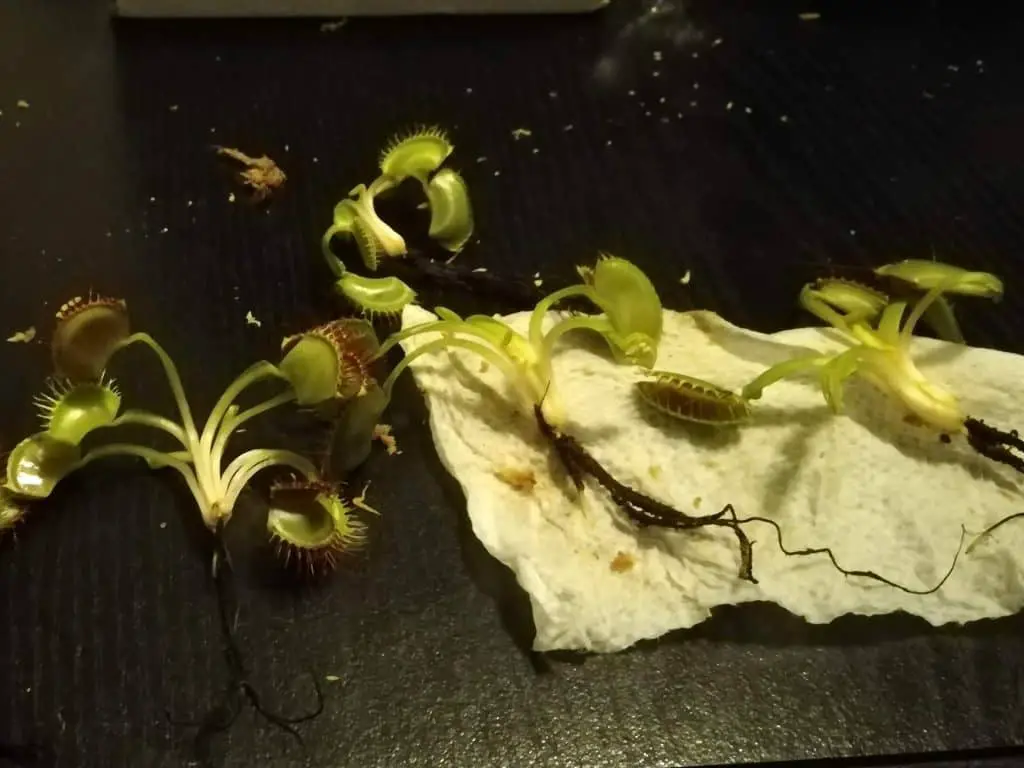In their natural environments, Venus flytraps live through winters every year. When the temperature drops Venus flytraps go dormant (similar to hibernation). Venus flytraps need dormancy to remain healthy.
Venus flytraps must go dormant for 3 to 4 months, if they do not experience this period of inactivity the plant will end up dying. Venus flytraps go dormant when they experience cold weather of less than 45F (7C) for a minimum of three months. There are methods to achieve dormancy indoors and outdoors.
Some areas have the perfect temperatures for Venus flytraps to go dormant in the winter. However, not all of us (including me) live in an area with cold winters. In this article, I will share different methods and a guide to Venus flytrap dormancy.
Venus flytraps can live a few years without dormancy, but they will continue to weaken and eventually die. If you want to ensure your plant stays healthy, make sure it goes dormant every single year. The process is not very challenging and I have methods that work for every climate.
Venus Flytrap Dormancy Guide
The first step to getting started with Venus flytrap dormancy is to learn the basics.
20-45 F is the optimal temperature range for Venus flytraps to go dormant during the winter. To achieve dormancy, Venus flytraps must be exposed to temperatures below 45 F for at least 3-4 weeks. After starting dormancy, Venus flytraps must remain in cold temperatures for 3-4 months.
| Venus flytrap Dormancy Considerations | Recommendation |
| The optimal temperature range for dormancy | 20 – 45 F ( -6 – 7 C) |
| Minimum recommended temperature | 20 F ( -6 C) |
| Recommended length of dormancy | 3 – 4 months |
| How to begin dormancy | Introduce to shorter days and cold temperatures (below 45 F (7 C)) |
| How to exit dormancy | Wait until the spring starts and introduce slowly to more sunlight and warmer days |
The table above has some critical information that you will need to determine the best method to make your Venus flytrap go dormancy.
Overall, there are three options to achieve dormancy and these instructions will help you determine the most suitable option.
- Outdoor dormancy: If you are able to grow your Venus flytraps outdoors in the winter and your area has temperatures of below 45F for 3-4 months, then outdoor dormancy might be the best option. The only other consideration besides having a cold winter is the extreme temperatures. Avoid growing your venus flytrap outdoors when temperatures drop substantially. Temperatures below 20 F can sometimes harm Venus flytraps. Consider indoor dormancy if you believe temperatures can be too extreme during the winter months.
- Indoor dormancy: Whether grown indoors or outdoors, Venus flytraps will require cold temperatures. Venus flytraps exposed to chilly temperatures in unheated garages, basements, and indoor patios can go dormant with great success. Also, cold indoor locations provide some protection from extreme temperatures, snow storms, etc.
- Refrigerator dormancy: As a last resort you can place your venus flytrap in the fridge to make it go dormant. I only recommend this option if your location does not have a winter season. There is a method
It is ok if the temperatures rise to 50 F or above during the day or if there is a warm day in the middle of the winter. Temperature is never consistent in nature. Your Venus flytrap should remain dormant unless the temperature changes for a considerable amount of time.
The Best Timing for Venus Flytrap Dormancy
Venus fly traps go dormant whenever the winter starts.
The best time for Venus flytraps to go dormant is during YOUR winter. There is no need to time dormancy in any specific months. You can follow the instructions in the guides below when you are ready to start the dormancy process.
The most important timing consideration is consistency. Venus flytraps must go dormant every year at above a similar time. if you decide to induce dormancy, make sure you can continue that cycle every 12 months ago and again.
How to Identify Dormant Venus Fly traps
Once Venus fly traps start to go dormant, they change in appearance.
Dormant Venus fly traps have a similar appearance than dead plants. They loose multiple leaves, shrink in size, and stop growing for several months. If your are unsure your plant is dead or just dormant, continue to care for it until the end of dormancy.
A good rule of thumb is that dead Venus fly traps often look mushy and have no green leaves. And dormant Venus fly traps can only be in such state if there is cold weather.
Venus Flytrap Dormancy Outdoors
Venus flytraps going dormant outdoors is the optimal scenario. They naturally grow in the states of Soth Carolina and North Caroline where they have plenty of access to cold temperatures during the winter months.
For Venus flytraps growing outdoors already the process is very easy. Just leave your plant outside and the weather will trigger dormancy. As soon as the temperatures start to drop and the days become shorter, Venus flytraps will start going dormancy. You do not have to do anything else to trigger dormancy.
Venus flytraps go dormant after 2-3 weeks of chilly temperatures. You will notice some differences as your plant will likely look down and lose several leaves. It is completely normal. Do not worry too much and do not toss it. Dead and dormant venus flytraps look alike.
During the dormancy months, I recommend trimming dead leaves and following the complete care instructions I outline later in this article. Avoid moving the plant and creating additional stress and let the weather do its magic.
Venus flytraps will exit dormancy slowly as days become longer and temperatures start to rise. Once Venus flytraps are out of dormancy the spring will prompt them to start producing flowers and reproduce.
Venus Flytrap Dormancy Indoors
Venus flytraps can easily go dormant indoors as long as temperatures drop below 45 F.
For indoor dormancy, place your Venus flytrap in a cold location, such as a windowsill, an unheated garage, porch, basement, or any room that has a suitable temperature range (below 45 F). Venus flytraps will slowly go dormant after being exposed to chilly temperatures.
It usually takes 2-3 weeks to see the changes in your plant. The plant will likely die down and lose many leaves.
During the dormancy period, you can provide artificial or natural light to your plants. Technically, when Venus flytraps are completely dormant due to cold weather, they won’t require light. However, it is hard to know if your plant is 100% dormant when you can’t control the weather. For that reason, I recommend providing some lighting during dormancy to ensure your plant remains healthy.
After 3 months you can make your Venus flytrap exit dormancy. You can also wait longer 4 to 5-month dormancy are also acceptable.
Your plant will exit dormancy once it has access to warmer weather and more light. However, sudden changes can harm your plant. Slowly increase the lighting for your plant for a few weeks (like an extra hour every couple of days). Then, slowly start removing the plant from the cold location.
Once your plant is growing again in a warmer environment you will see significant changes as it starts to reflourish.
Refrigerator Dormancy
This method is reserved for extreme circumstances. For anyone that does not live in an area that has a cold enough winter, the dormancy method is really the only choice besides skipping dormancy.
If you are looking to keep your plant alive for many years (even decades), it is time to evaluate an alternate option. You can induce dormancy by placing Venus flytraps in the fridge. You can place your Venus flytrap and its pot in the fridge or remove all soil from your plant and place it in the fridge. These are the steps you need to follow to complete the process:
Start by getting some sulfur-based fungicide. Physan is a good option. Here is a link to the product on Amazon https://amzn.to/3vr9lGu It’s perfectly safe and not too expensive.
Then, make space in your fridge. Your plant will need to be there for at least three months before exiting dormancy.

Method 1- Keeping The Pot
If you have enough space in your fridge I recommend keeping your plant in its pot. However, keep in mind that they can take up significant space depending on the size of the pot and the number of plants you own.
Materials
- Space in your fridge
- Distilled water
- An air-tight container big enough to hold your potted plant
- Scissors for trimming
- Optional: Sulfur-based fungicide and spray bottle
Instructions
- Remove all black and dead leaves from your plant. Also, remove any foliage from the soil.
- Water your plant so the soil is humid
- Optional: spray your plants with fungicide throughout
- Grab a large Ziploc bag air-tight container and place your whole plant with its pot inside.
- Seal the containers. Keeping it open will dry out the soil almost immediately and end up killing your plant.
- Place your plant inside the fridge (not the freezer)
- Keep the plants in the fridge and check on them every few days and watch out for mold, rotting, and not enough water.
- Water your plant when the soil is starting to dry out, but avoid overwatering
- After 3 months remove your plants from the fridge and reintroduce them to light and warmer temperatures slowly
Method 2 – Unpotting Your Plant
This method does not require much space for your plants but is slightly more challenging.
Required Materials
- Distilled water
- Long fibered sphagnum moss
- Scissors for trimming
- Fresh soil
- Space in your fridge
- Optional: sulfur-based fungicide and spray bottle
Instructions
- Unpot your Venus flytrap removing all the soil from the roots
- Trim dead leaves and roots
- Optional: spray your plant with a fungicide
- Grab sphagnum moss and moisten it with distilled water
- Wrap your Venus flytrap with the moss and place it inside an air-tight container like a Ziploc bag
- Seal the container and place your plant in the fridge.
- Keep the plants in the fridge and check on them every few days and watch out for mold, rotting, and not enough water.
- Water your plant when the moss starts to dry out by spraying distilled water.
- After 3 months remove your plants from the fridge and plant them into fresh soil
- Slowly reintroduce your plant to warm weather and light. I recommend taking 2-3 weeks slowly transition your plant from the fridge into its growing space.

Skipping Venus Flytrap Dormancy
Venus flytrap dormancy is an essential process that allows the plant to rest and remain strong in the growing season. Venus flytraps should go dormant every single year. However, it is not always possible to provide an appropriate environment for dormancy.
When Venus flytraps skip dormancy, their growth becomes stagnant compared to other Venus flytraps growing rapidly after dormancy. Without dormancy, Venus flytraps are also less likely to propagate. Venus flytraps that skip 2-3 yearly dormancy periods in a row weaken and eventually die.
Venus flytraps can skip dormancy as long as it is not a recurring practice. The plant will exhibit a slow growth rate but will eventually recover as it goes dormant in the years to come.
Skipping dormancy is a suitable choice in some specific circumstances, such as:
- When growing seedlings or leaf cuttings/ pullings
- When you just got a new plant
- When you are a short-term Venus flytrap owner
This article covers the best strategies of how to skip venus flytrap dormancy if that is your only option.
Care During Venus Flytrap Dormancy
Care during dormancy is a bit trickier than during growing seasons. Here are some tips to ensure they complete dormancy healthy.
- Watering: Continue to water your plant often, but be ready to lower the watering frequency. Dormant Venus flytraps consume less water. Make sure you feel the soil after watering to ensure it is only moist but not damped. Overwatering is a very common cause of death during the winter months.
- Fertilizers: Do not fertilize Venus flytraps during dormancy. Generally is not recommended to fertilize these plants if you are a novice, but dormancy is discouraged for all.
- Feeding: Avoid feeding your Venus flytrap during this period. If it catches a bug on its own, that is ok. But, do not feed it manually. Your plant is in a resting state and it does not require any additional nutrients.
- Trimming: Carefully trim and remove dead leaves as they wither. removing dead leaves can help avoid the presence of mold and algae.
- Repotting: Avoid repotting your plant in the middle or start of dormancy. However, repotting at the end of dormancy is a common and useful practice. Wait until your plant is about to exit dormancy to repot. This guide will teach you how to repot successfully.
Also, I recommend reading my complete venus flytrap care guide to ensure you don’t make any mistakes during dormancy. During the winter months, your plant will be more sensitive to any mistakes.
Dead vs Dormant Venus Flytrap
During dormancy, Venus flytraps change significantly. The plant reduces in size and it losses most of its leaves.
An increase in black leaves is completely normal during this period. Do not be overly worried about the changes in your plant. Some plants will experience drastic changes and others very mild ones.
The worst thing you can do is overreact and try to change things in your setup. Instead, I recommend following the dormancy care instructions I shared and ensuring you are providing the optimal environment. Continue to be patient and wait as the weeks and months go by. When the temperatures start to rise you will notice significant changes in your plant. New leaves will start to grow and your plant might even produce some flowers.


